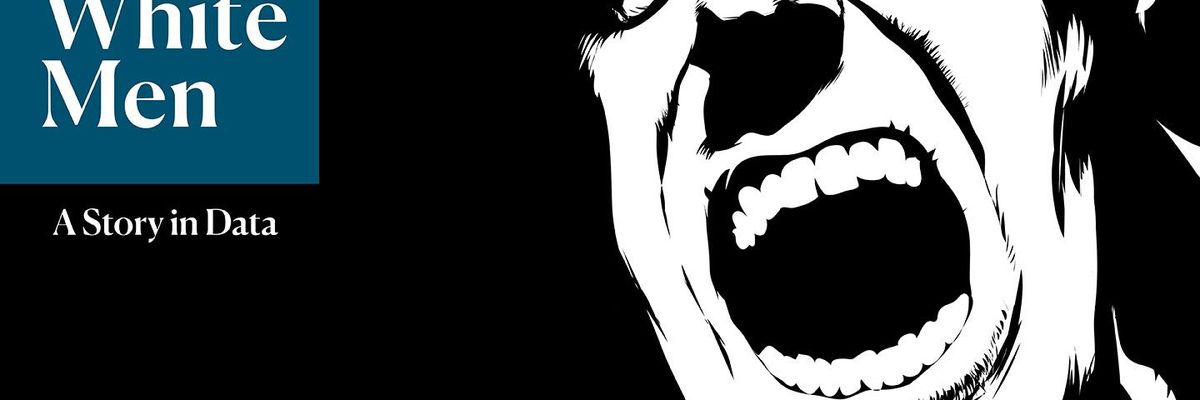

SUBSCRIBE TO OUR FREE NEWSLETTER
Daily news & progressive opinion—funded by the people, not the corporations—delivered straight to your inbox.
5
#000000
#FFFFFF
To donate by check, phone, or other method, see our More Ways to Give page.


Daily news & progressive opinion—funded by the people, not the corporations—delivered straight to your inbox.

The rise in these public-place mass shootings and extremist violence correlates with the rise in rhetoric on White supremacy, xenophobia, and misogyny. (Photo: YES! Infographic by Tracy Matsue Loeffelholz)
"Invasion." President Trump has used that very word about immigration at the southern border 19 times at rallies since he took office, according to a recent USA Today analysis. And six tweets between October 2018 and June 2019 use the word "invasion" that way.
An arrest affidavit for 21-year-old Patrick Crusius, the man charged in the Aug. 3 mass shooting in an El Paso, Texas, Walmart that left 22 people dead and 24 wounded, reportedly says Crusius told police he was targeting Mexicans. Crusius allegedly referenced wanting to stop a "Hispanic invasion" of Texas in a statement on a right-wing online messaging board about 20 minutes before the shooting.
In one week, between July 31 and August 3, three White men massacred and wounded dozens of people in Gilroy, California; Dayton, Ohio; and El Paso. Media often jump to analysis of mass shootings around gun control and mental illness. But what about their connection to electoral politics? Or misogyny in the face of feminist movements?
A lot of data exists to answer some of these questions and challenge notions that a mass shooter is likely a jihadist, or a mentally ill person illegally stockpiling assault weapons. In fact, the rise in these public-place mass shootings and extremist violence correlates with the rise in rhetoric on White supremacy, xenophobia, and misogyny. In the data, a picture emerges of the American terrorist and what sets him off.
Trump and Musk are on an unconstitutional rampage, aiming for virtually every corner of the federal government. These two right-wing billionaires are targeting nurses, scientists, teachers, daycare providers, judges, veterans, air traffic controllers, and nuclear safety inspectors. No one is safe. The food stamps program, Social Security, Medicare, and Medicaid are next. It’s an unprecedented disaster and a five-alarm fire, but there will be a reckoning. The people did not vote for this. The American people do not want this dystopian hellscape that hides behind claims of “efficiency.” Still, in reality, it is all a giveaway to corporate interests and the libertarian dreams of far-right oligarchs like Musk. Common Dreams is playing a vital role by reporting day and night on this orgy of corruption and greed, as well as what everyday people can do to organize and fight back. As a people-powered nonprofit news outlet, we cover issues the corporate media never will, but we can only continue with our readers’ support. |
"Invasion." President Trump has used that very word about immigration at the southern border 19 times at rallies since he took office, according to a recent USA Today analysis. And six tweets between October 2018 and June 2019 use the word "invasion" that way.
An arrest affidavit for 21-year-old Patrick Crusius, the man charged in the Aug. 3 mass shooting in an El Paso, Texas, Walmart that left 22 people dead and 24 wounded, reportedly says Crusius told police he was targeting Mexicans. Crusius allegedly referenced wanting to stop a "Hispanic invasion" of Texas in a statement on a right-wing online messaging board about 20 minutes before the shooting.
In one week, between July 31 and August 3, three White men massacred and wounded dozens of people in Gilroy, California; Dayton, Ohio; and El Paso. Media often jump to analysis of mass shootings around gun control and mental illness. But what about their connection to electoral politics? Or misogyny in the face of feminist movements?
A lot of data exists to answer some of these questions and challenge notions that a mass shooter is likely a jihadist, or a mentally ill person illegally stockpiling assault weapons. In fact, the rise in these public-place mass shootings and extremist violence correlates with the rise in rhetoric on White supremacy, xenophobia, and misogyny. In the data, a picture emerges of the American terrorist and what sets him off.
"Invasion." President Trump has used that very word about immigration at the southern border 19 times at rallies since he took office, according to a recent USA Today analysis. And six tweets between October 2018 and June 2019 use the word "invasion" that way.
An arrest affidavit for 21-year-old Patrick Crusius, the man charged in the Aug. 3 mass shooting in an El Paso, Texas, Walmart that left 22 people dead and 24 wounded, reportedly says Crusius told police he was targeting Mexicans. Crusius allegedly referenced wanting to stop a "Hispanic invasion" of Texas in a statement on a right-wing online messaging board about 20 minutes before the shooting.
In one week, between July 31 and August 3, three White men massacred and wounded dozens of people in Gilroy, California; Dayton, Ohio; and El Paso. Media often jump to analysis of mass shootings around gun control and mental illness. But what about their connection to electoral politics? Or misogyny in the face of feminist movements?
A lot of data exists to answer some of these questions and challenge notions that a mass shooter is likely a jihadist, or a mentally ill person illegally stockpiling assault weapons. In fact, the rise in these public-place mass shootings and extremist violence correlates with the rise in rhetoric on White supremacy, xenophobia, and misogyny. In the data, a picture emerges of the American terrorist and what sets him off.